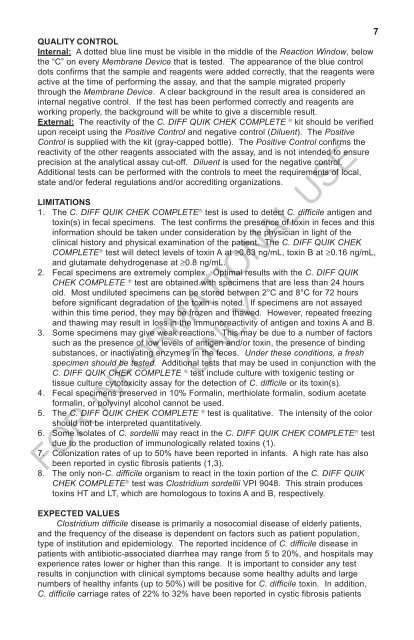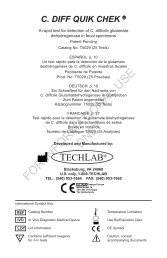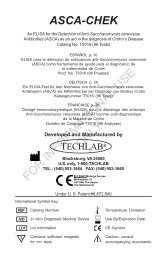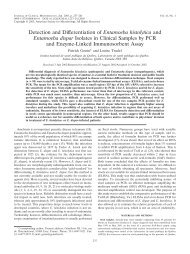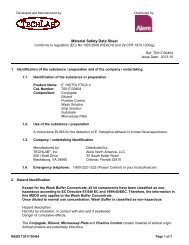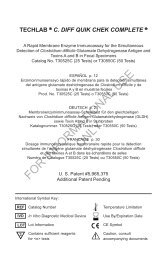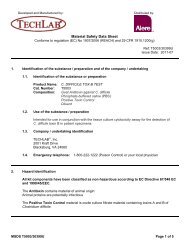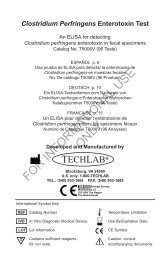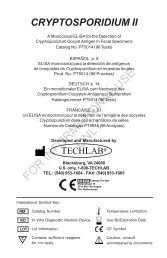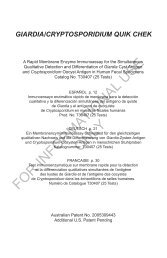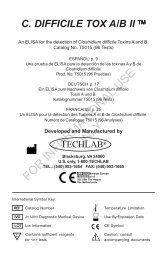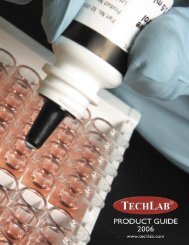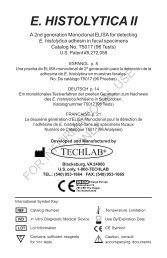Wampole C. DIFF QUIK CHEK COMPLETE 11-2011.pmd - TechLab
Wampole C. DIFF QUIK CHEK COMPLETE 11-2011.pmd - TechLab
Wampole C. DIFF QUIK CHEK COMPLETE 11-2011.pmd - TechLab
You also want an ePaper? Increase the reach of your titles
YUMPU automatically turns print PDFs into web optimized ePapers that Google loves.
7QUALITY CONTROLInternal: A dotted blue line must be visible in the middle of the Reaction Window, belowthe “C” on every Membrane Device that is tested. The appearance of the blue controldots confirms that the sample and reagents were added correctly, that the reagents wereactive at the time of performing the assay, and that the sample migrated properlythrough the Membrane Device. A clear background in the result area is considered aninternal negative control. If the test has been performed correctly and reagents areworking properly, the background will be white to give a discernible result.External: The reactivity of the C. <strong>DIFF</strong> <strong>QUIK</strong> <strong>CHEK</strong> <strong>COMPLETE</strong> ® kit should be verifiedupon receipt using the Positive Control and negative control (Diluent). The PositiveControl is supplied with the kit (gray-capped bottle). The Positive Control confirms thereactivity of the other reagents associated with the assay, and is not intended to ensureprecision at the analytical assay cut-off. Diluent is used for the negative control.Additional tests can be performed with the controls to meet the requirements of local,state and/or federal regulations and/or accrediting organizations.LIMITATIONS1. The C. <strong>DIFF</strong> <strong>QUIK</strong> <strong>CHEK</strong> <strong>COMPLETE</strong> ® test is used to detect C. difficile antigen andtoxin(s) in fecal specimens. The test confirms the presence of toxin in feces and thisinformation should be taken under consideration by the physician in light of theclinical history and physical examination of the patient. The C. <strong>DIFF</strong> <strong>QUIK</strong> <strong>CHEK</strong><strong>COMPLETE</strong> ® test will detect levels of toxin A at ≥0.63 ng/mL, toxin B at ≥0.16 ng/mL,and glutamate dehydrogenase at ≥0.8 ng/mL.2. Fecal specimens are extremely complex. Optimal results with the C. <strong>DIFF</strong> <strong>QUIK</strong><strong>CHEK</strong> <strong>COMPLETE</strong> ® test are obtained with specimens that are less than 24 hoursold. Most undiluted specimens can be stored between 2°C and 8°C for 72 hoursbefore significant degradation of the toxin is noted. If specimens are not assayedwithin this time period, they may be frozen and thawed. However, repeated freezingand thawing may result in loss in the immunoreactivity of antigen and toxins A and B.3. Some specimens may give weak reactions. This may be due to a number of factorssuch as the presence of low levels of antigen and/or toxin, the presence of bindingsubstances, or inactivating enzymes in the feces. Under these conditions, a freshspecimen should be tested. Additional tests that may be used in conjunction with theC. <strong>DIFF</strong> <strong>QUIK</strong> <strong>CHEK</strong> <strong>COMPLETE</strong> ® test include culture with toxigenic testing ortissue culture cytotoxicity assay for the detection of C. difficile or its toxin(s).4. Fecal specimens preserved in 10% Formalin, merthiolate formalin, sodium acetateformalin, or polyvinyl alcohol cannot be used.5. The C. <strong>DIFF</strong> <strong>QUIK</strong> <strong>CHEK</strong> <strong>COMPLETE</strong> ® test is qualitative. The intensity of the colorshould not be interpreted quantitatively.6. Some isolates of C. sordellii may react in the C. <strong>DIFF</strong> <strong>QUIK</strong> <strong>CHEK</strong> <strong>COMPLETE</strong> ® testdue to the production of immunologically related toxins (1).7. Colonization rates of up to 50% have been reported in infants. A high rate has alsoFOR INFORMATIONAL USEONLYbeen reported in cystic fibrosis patients (1,3).8. The only non-C. difficile organism to react in the toxin portion of the C. <strong>DIFF</strong> <strong>QUIK</strong><strong>CHEK</strong> <strong>COMPLETE</strong> ® test was Clostridium sordellii VPI 9048. This strain producestoxins HT and LT, which are homologous to toxins A and B, respectively.EXPECTED VALUESClostridium difficile disease is primarily a nosocomial disease of elderly patients,and the frequency of the disease is dependent on factors such as patient population,type of institution and epidemiology. The reported incidence of C. difficile disease inpatients with antibiotic-associated diarrhea may range from 5 to 20%, and hospitals mayexperience rates lower or higher than this range. It is important to consider any testresults in conjunction with clinical symptoms because some healthy adults and largenumbers of healthy infants (up to 50%) will be positive for C. difficile toxin. In addition,C. difficile carriage rates of 22% to 32% have been reported in cystic fibrosis patients


